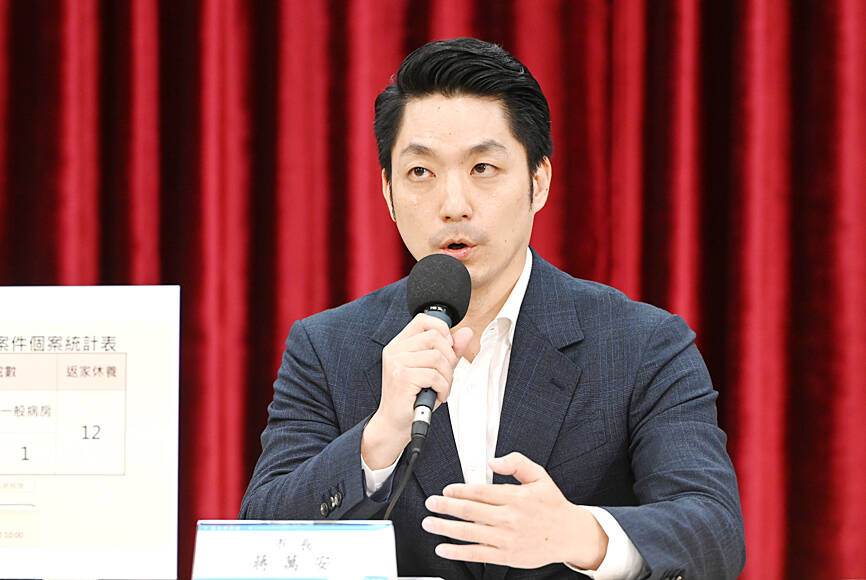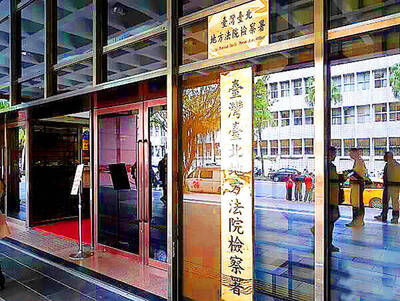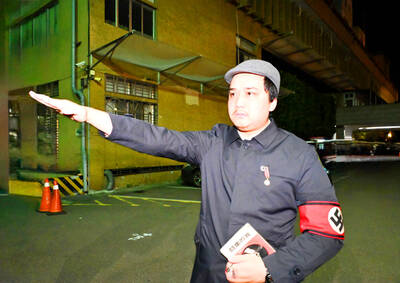The Taipei City Government yesterday said its inspection of a restaurant linked to a bongkrek acid poisoning outbreak found that a specimen collected from the chef’s hands on March 24 had tested positive for the toxin, so the restaurant would be held responsible for the food poisoning.
Thirty people who ate at Polam Kopitam (寶林茶室) in Far Eastern Department Store Xinyi A13 (Xinyi A13) between March 19 and 24 have reported falling ill after eating there, with most of them having eaten a stir-fried flat rice noodle dish called char kway teow (炒粿條).
Bongkrek acid, a rare toxin produced by contamination with a bacterium, especially in fermented coconut or corn food products, was found in the blood of 14 patients, including two who died, but the toxin was not found in food ingredients collected at the restaurant on March 26 or from the rice noodle dish supplier.

Photo: Tien Yu-hua, Taipei Times
Taipei Mayor Chiang Wan-an (蔣萬安) yesterday said when the city government received a report from the New Taipei City Government about the first death on March 24, it sent inspectors to check the restaurant and conducted environmental and food-worker specimen collections on that day.
The collected specimens included two from knives, one from a cutting board, and a swab sample from the chef’s hands, he said, adding that they were sent to National Taiwan University’s (NTU) Department of Forensic Medicine for testing on Monday, and the results came back positive in the evening.
“Polam, you cannot run away from your responsibility,” the mayor said, adding that upon receiving the test result, the city government immediately reported it to prosecutors and the city’s police department on Monday evening.
Taipei Department of Legal Affairs Commissioner Lien Tang-kai (連堂凱) said as the specimen tested positive, it can be confirmed that the food poisoning occurred at the Xinyi A13 restaurant, so the department would start negotiating with the concerned insurance companies about insurance claims, starting with the more urgent medical fees.
Chiang said details on the source and contamination route are being investigated by prosecutors, while the central government is cultivating the bacterium, and police are looking at surveillance cameras to clarify the situation.
After lawmakers questioned Minister of Health and Welfare Hsueh Jui-yuan’s (薛瑞元) assertion that flat rice noodles used in those few days are the most likely source of the toxin, Department Commissioner Chen Yen-yuan (陳彥元) said: “This is a very scientific assessment.”
Aside from testing, contact tracing investigators also conducted an epidemiological survey on the patients on what they ate in the past few days and at the Xinyi A13 restaurant, Chen said.
“Scientifically, we will determine what has the highest probability, so I believe there is no doubt about his assessment,” he said.
“This is why we all believe the flat rice noodle is the problem, in order of probability,” Chen said. “But [it can be better determined] if we can find any direct evidence, just like the hand swab sample collected by our frontline inspectors that tested positive, which is direct evidence that echoes the assessment made by the department and the ministry.”
Separately, NTU Department of Forensic Medicine adjunct associate professor Weng Te-i (翁德怡), who tested the specimens, yesterday said the specimens were collected on March 24 originally for common pathogenic bacteria cultivation as a normal procedure, because “at first, no one knew it was this serious.”
The Centers for Disease Control (CDC) called a specialists’ meeting on Wednesday last week, in which the experts determined bongkrek acid to be a possible cause, she said.
As no common pathogenic bacteria grew after a week, Chen suggested testing the culture medium for bongkrek acid, and it unexpectedly came back positive, she said.
Finding the bongkrek acid on the chef’s hands can narrow the search for the toxin source to the restaurant’s kitchen, as previously the toxin was found in some patients’ blood samples, but they could have all been exposed to it from the tables in the food court or some other part of the department store, she said.
“We can now prove that bongkrek acid had been at Polam Kopitam in Xinyi A13 at the time,” Weng said, adding that the chef’s hands might not be the original source of the toxin, but his hands were exposed to it every time he touched the contaminated food ingredient, so the amount was low but still detectable.
Meanwhile, the CDC’s statistics showed that as of 5:30pm yesterday, 30 people fell ill after eating at the Xinyi A13 restaurant, including two deaths, four in intensive care, two still in hospital and 22 who have since returned to their homes after treatment.

INVESTIGATION: The case is the latest instance of a DPP figure being implicated in an espionage network accused of allegedly leaking information to Chinese intelligence Democratic Progressive Party (DPP) member Ho Jen-chieh (何仁傑) was detained and held incommunicado yesterday on suspicion of spying for China during his tenure as assistant to then-minister of foreign affairs Joseph Wu (吳釗燮). The Taipei District Prosecutors’ Office said Ho was implicated during its investigation into alleged spying activities by former Presidential Office consultant Wu Shang-yu (吳尚雨). Prosecutors said there is reason to believe Ho breached the National Security Act (國家安全法) by leaking classified Ministry of Foreign Affairs information to Chinese intelligence. Following interrogation, prosecutors petitioned the Taipei District Court to detain Ho, citing concerns over potential collusion or tampering of evidence. The

Seventy percent of middle and elementary schools now conduct English classes entirely in English, the Ministry of Education said, as it encourages schools nationwide to adopt this practice Minister of Education (MOE) Cheng Ying-yao (鄭英耀) is scheduled to present a report on the government’s bilingual education policy to the Legislative Yuan’s Education and Culture Committee today. The report would outline strategies aimed at expanding access to education, reducing regional disparities and improving talent cultivation. Implementation of bilingual education policies has varied across local governments, occasionally drawing public criticism. For example, some schools have required teachers of non-English subjects to pass English proficiency

‘FORM OF PROTEST’: The German Institute Taipei said it was ‘shocked’ to see Nazi symbolism used in connection with political aims as it condemned the incident Sung Chien-liang (宋建樑), who led efforts to recall Democratic Progressive Party (DPP) Legislator Lee Kun-cheng (李坤城), was released on bail of NT$80,000 yesterday amid an outcry over a Nazi armband he wore to questioning the night before. Sung arrived at the New Taipei City District Prosecutors’ Office for questioning in a recall petition forgery case on Tuesday night wearing a red armband bearing a swastika, carrying a copy of Adolf Hitler’s Mein Kampf and giving a Nazi salute. Sung left the building at 1:15am without the armband and apparently covering the book with a coat. This is a serious international scandal and Chinese

TRADE: The premier pledged safeguards on ‘Made in Taiwan’ labeling, anti-dumping measures and stricter export controls to strengthen its position in trade talks Products labeled “made in Taiwan” must be genuinely made in Taiwan, Premier Cho Jung-tai (卓榮泰) said yesterday, vowing to enforce strict safeguards against “origin laundering” and initiate anti-dumping investigations to prevent China dumping its products in Taiwan. Cho made the remarks in a discussion session with representatives from industries in Kaohsiung. In response to the US government’s recent announcement of “reciprocal” tariffs on its trading partners, President William Lai (賴清德) and Cho last week began a series of consultations with industry leaders nationwide to gather feedback and address concerns. Taiwanese and US officials held a videoconference on Friday evening to discuss the